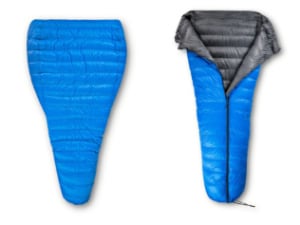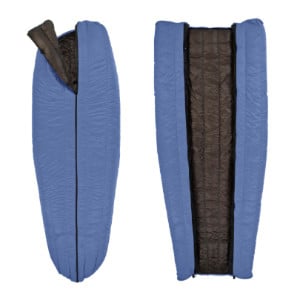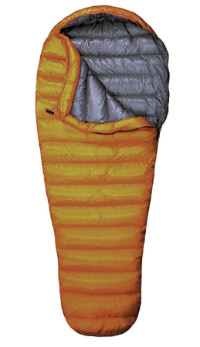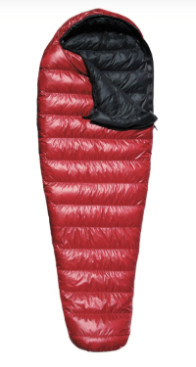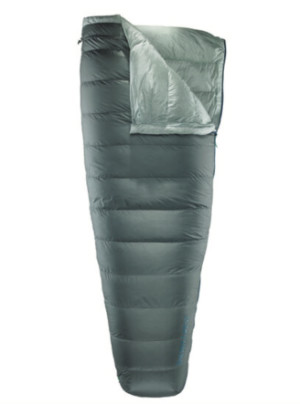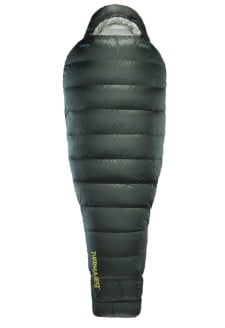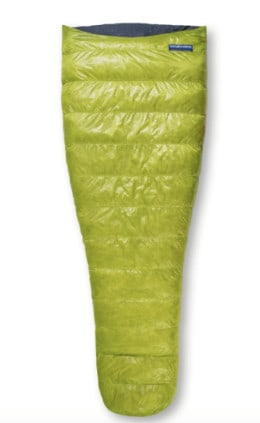Many ultralight sleeping bags are as lightweight as backpacking quilts, making them a viable component in an ultralight backpacking sleep system. Sleeping bags also have the advantage over quilts in that they are draft free because they can be zippered closed at night and because there are no pad attachment straps to mess around with in the dark. Many ultralight sleeping bags are also available without mummy hoods and can be easily vented, providing all of the comfort advantages of backpacking quilts for people who prefer hoodless sleep insulation.
Here are the 10 best ultralight sleeping bags that we recommend:
1. Feathered Friends Flicker 40
2. Enlightened Equipment Convert 40 Sleeping Quilt
The Enlightened Equipment Convert features a full-length zipper and a fully adjustable and ventable footbox which allows it to be completely closed (like a sleeping bag), completely open (like a blanket), or somewhere in between. It’s available with 850 or 950 fill power down, a draft collar, different lengths and widths, and a wide variety of colors and fabric weights. For example, a 40-degree 850-fill power read-to-ship Convert Sleeping Bag weighs just 20.52 oz. Read the SectionHiker Convert Review.
3. Western Mountaineering Flylite 36
4. Sea-to-Summit Spark 40 Sleeping Bag
5. Western Mountaineering Summerlite 32
6. Western Mountaineering Highlight 35 Sleeping Bag
7. Therm-a-Rest Ohm 20 Sleeping Bag
8. Therm-a-Rest Hyperion 20 Sleeping Bag
9. Feather Friends Tanager 20 Sleeping Bag
10. Zpacks Mummy Sleeping Bag 20
Ultralight Sleeping Bag Guide
Here is a list of key considerations when deciding between different ultralight sleeping bag options.
Mummy or Rectangular (Hoodless) Sleeping Bags?
Ultralight sleeping bags are available with mummy hoods or as hoodless rectangular bags, similar to quilts. Which you choose is a matter of personal preference, but a mummy hood can be a real bonus in colder temperatures when more head insulation is warranted. When sleeping in a hoodless sleeping bag, you’ll want to use some sort of head covering, like a fleece or down cap, or sleep in a puffy down jacket with a hood to keep you head warm and seal out drafts at the top of the bag.
Must-have Features
Ultralight sleeping bags should have a draft collar, zipper draft tubes, and snag-free zippers at a minimum. Partial-length zippers, continuous baffles, and even water-resistant down are all nice-to-haves, but you can get by without them to save on cost or because they’re not strictly necessary.
Draft Collar
Most high-quality ultralight sleeping bags have draft collars which is an important feature on bags rated for 20 degrees F or colder. A draft collar is a tube of insulation that drapes over your chest and neck and seals in the bag’s warmth. Without it, the warm air inside the bag will rush out around your neck when you move around inside. The simplest draft collar is a down tube that covers the front of your chest. Higher-end bags add a second draft collar around the back of your shoulders and neck and provide additional controls, so you can tighten or loosen it.
Zipper Draft Tubes
Draft tubes are down-filled tubes of fabric that cover up the side zipper so your legs don’t come in contact with it (because it’s cold). They also prevent cold air from leaking into the bag through the needle holes that are created when sewing the zipper to the bag. Most bags have at least one zipper draft tube, although some have two, both top and bottom, that fall into place when you zip up your bag.
Snag Free Zipper
Snag-free zippers prevent the side zipper’s teeth from tearing the shell fabric of your bag and spilling its insulation. The zipper is usually bordered by stiff fabric tape, to keep it away from the down baffles and prevent it from getting snagged on the bag’s outer shell.
Nice-to-have features
Water-Resistant Down
Water-resistant down is a nice to have, not a must-have in an ultralight sleeping bag. The truth is most people can keep their sleeping bags dry. If you notice moisture on the outside of your sleeping bag in the morning, it doesn’t mean that the down inside is wet. Simply drape it over your tent in the sun while you eat breakfast and it will dry in no time.
Continuous baffles
Continuous baffles usually run horizontally across a bag. They allow you to shake the down in the baffles and move it to a different location. For example, if you’re too warm, you could shake the down so it fell down the sides of the bag, rather than keep it on your chest. While continuous baffles let you customize the distribution of down for different needs, many people prefer baffles that keep the down in one place reliably and permanently. It’s one less thing to worry about.
Partial length zippers
Partial-length zippers are often used as a weight-saving feature, however, they can reduce use across a wider temperature range by limiting your venting options.
SectionHiker is reader-supported. We only make money if you purchase a product through our affiliate links. Help us continue to test and write unsponsored and independent gear reviews, beginner FAQs, and free hiking guides.

